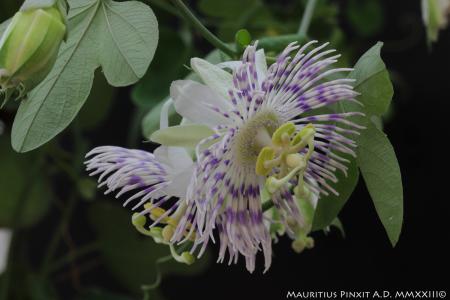
SUBGENUS: passiflora
SUPERSECTION: stipulata
SECTION: granadillastrum
GEOGRAPHICAL DISTRIBUTION OR ORIGIN:
Southern Bolivia and northern Argentina above 2,800 meters of altitude.
MINIMUM TEMPERATURE: -10 °C
IDEAL MINIMUM TEMPERATURE: 0 °C
SYNONYMS: P. naviculata Griseb., P. tucumanenis var. naviculata Hicken.
ETYMOLOGY: Denomination of geographical origin: it takes its name from Tucuman, a locality of Argentina, where this species lives.
DESCRIPTION:
P. tucumanensis, formerly called P. naviculata and native to the mountains of Paraguay, Argentina and Bolivia, is little known although it has at least two interesting peculiarities.
First of all, the colours of its flowers are delicate: the white of the petals and sepals is enlivened by the corona of filaments, also white, but contrasted by mauve bands.
The other valued element is its excellent resistance to cold. This passionflower deserves to be more widespread across our peninsula, which has quite a few climatic zones that are suited to it.
It resists sub-zero temperatures (-10°C) well and tolerates harsh frosts. If the aerial part is damaged by the cold, it can vegetate anew from the roots, emitting new suckers when spring arrives, much like P. incarnata and P. lutea. Consequently, it is important to protect the base with a good layer of peat when the first autumn cold arrives and keep it as dry as possible, also protecting it from waterlogging.
However, grown in pots of 20-30 cm in diameter, it is also an excellent pot plant and, even in this setting, can be very decorative. It is important, however, to use rich, well-drained soil.
P. tucumanensis has stems that are both thin and stiff. The leaves are trilobate, with some exceptions in more fully-grown specimens that may have five-lobed leaves. Two large reniform stipules with a pointed apex decorate the base of the leaf petiole, which is devoid of glands.
The pendulous flowers, with a diameter of about 5 cm, have an open corolla. The sepals end with a small rostrum and, like the petals, are white in colour.
The corona, formed by 5 series of filaments and positioned almost parallel to the corolla itself, is the most conspicuous part of the flower, with white bands alternating with coloured ones. The former has soft colours as if not wanting to disturb the dominant whiteness too much, and are more extensive than the latter.
The fruits,
yellow and globose, have a diameter of about 2-3 cm. It reproduces from seed,
root suckers and cuttings; the latter method, however, is not always quick and
efficient.